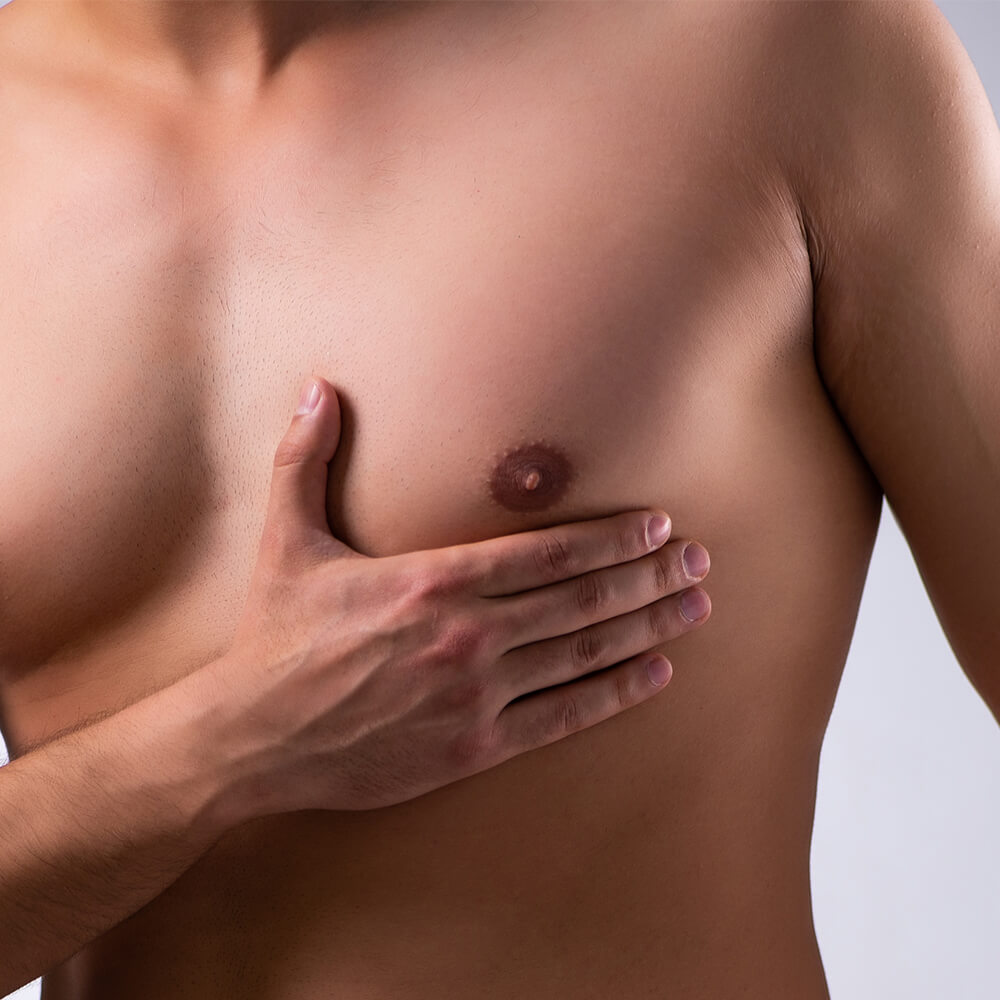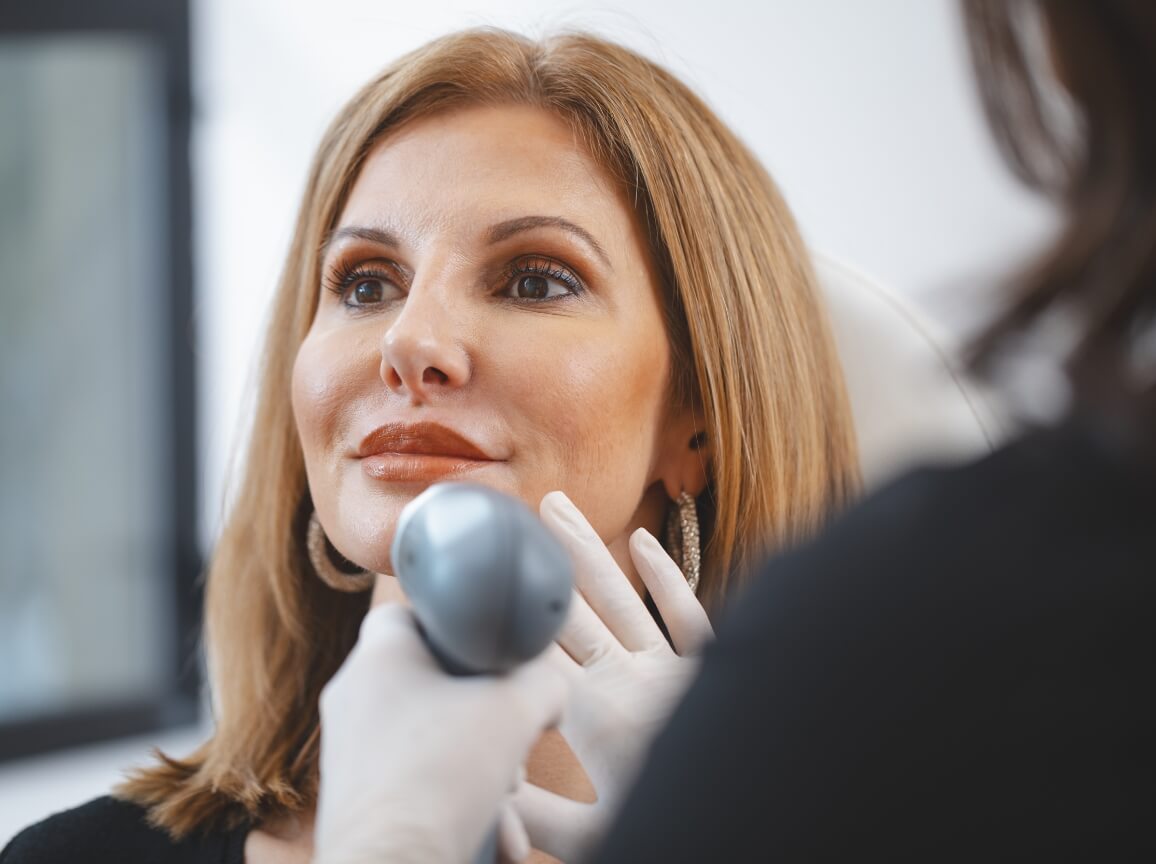Male Breast Reduction In Grass Valley, CA
 Model
Model
“Gynecomastia” is a medical term that comes from the Greek for “women-like breasts.” Though this oddly named condition is rarely talked about, it’s actually quite common. Gynecomastia affects an estimated 40 to 60 percent of men. It may affect only one breast or both. Though certain drugs and medical problems have been linked with male breast overdevelopment, there is no known cause in the vast majority of cases.
 Model
Model
You don’t have to live with this condition forever; male breast reduction surgery is a straightforward and effective procedure that can yield fantastic results. Dr. Lattyak and our team at the Élan Clinic are dedicated to providing safe, satisfying results through diligent care and attention to detail.
What Is Male Breast Reduction?
For men who feel self-conscious about their appearance, male breast reduction or gynecomastia surgery can help. The procedure removes fat and/or glandular tissue (breast tissue) from the chest and, in extreme cases, removes excess skin. The end result is a more masculine chest that is flatter and has a more pleasing contour. The procedure involves liposuction, surgical excision, or a combination of both.
What Are the Benefits of Male Breast Reduction?
Gynecomastia can be a source of embarrassment and discomfort for many men. Male breast reduction surgery is proven to be effective in treating gynecomastia and provides the following benefits:
- A flatter, more masculine chest contour
- Increased confidence
- More clothing options
- Improved physical comfort
- Long-lasting results
Am I a Candidate for Male Breast Reduction?
Surgery to correct gynecomastia can be performed on healthy men of any age. The best candidates for male breast reduction:
- Have firm, elastic skin that will reshape the body’s new contours
- Are in good health
- Are nonsmokers or willing to quit
- Have realistic expectations for results
Surgery may not be suitable for the following patients:
- Obese men or overweight men who have not first tried diet and exercise as a treatment for gynecomastia
- Individuals who drink alcoholic beverages in excess or who use marijuana
Excess alcohol intake, marijuana, and anabolic steroids may cause gynecomastia. Therefore, patients are first directed to stop the use of these drugs to see if their breast fullness will diminish before surgery is considered an option.
What Are My Male Breast Reduction Options?
Surgical Excision
One technique is to surgically remove excess skin, fat, and glandular tissue from the breasts. This is usually reserved for more severe cases in which the weight of the breasts causes the skin to stretch and become distorted.
Liposuction
In other cases, fat is the primary cause of male breasts. If you have good skin elasticity and fat is the primary concern, Dr. Lattyak can use liposuction as a treatment. Through small incisions, he will use a thin cannula to remove the excess fat while contouring the tissues for a flatter result.
It is also possible, and quite common, to use a combination of excision and liposuction to treat gynecomastia.
Combining Your Male Breast Reduction With Other Procedures
If you’re considering cosmetic surgery to treat your gynecomastia, you may wish to consider combining this procedure with another. Many patients are surprised to find that combining plastic surgery procedures results in a shorter recovery period than if they have procedures performed separately, and you end up saving money on anesthesia and facility fees. If you have other areas you’d like to address, Dr. Lattyak will gladly discuss your options with you. The following procedures are commonly paired with gynecomastia surgery for even better results:
 Model
Model
Liposuction
Liposuction is a great way to smooth out body contours and make the results of a procedure more natural-looking. Adding liposuction to the abdomen, upper arms, or back can make your male breast reduction results much more impactful.
 Model
Model
Abdominoplasty
Tummy tucks are not just for women; abdominoplasty is an excellent procedure to combine with male breast reduction, as this procedure allows Dr. Lattyak to remove excess skin (which is great after major weight loss) and tighten the abdominal muscles. Once healed, abdominoplasty patients are able to exercise their abdominals more comfortably and effectively.
How Is Male Breast Reduction Performed?
Your Consultation
The initial consultation with Dr. Lattyak is very important. Dr. Lattyak will need a complete medical history, so check your own records ahead of time and be ready to provide this information. He’ll also examine your breasts and check for causes of gynecomastia, such as impaired liver function, use of estrogen-containing medications, or anabolic steroids. If a medical problem is the suspected cause, you’ll be referred to an appropriate specialist.
He may also recommend a mammogram or breast X-ray. This is helpful not only to rule out the very small possibility of breast cancer but also to determine the breast’s composition. Once Dr. Lattyak knows how much fat and glandular tissue is contained within the breasts, he can choose a surgical approach to best suit your needs.
Don’t hesitate to ask Dr. Lattyak any questions you may have during the initial consultation— including your concerns about the recommended treatment, possible results, or the costs involved.
If you’re interested in male breast reduction surgery and want to find out if you’re a good candidate, call the Élan Clinic today at (530) 273-3400 to schedule a consultation with Dr. Lattyak.
The Male Breast Reduction Procedure
Please note every patient is different, so you might have a different surgical plan from what’s outlined here. But generally, the male breast reduction procedure is as follows:
Male breast reduction surgery is performed using either general or local anesthesia, depending on the technique used and the details of the surgical plan. It is an outpatient procedure, meaning you’ll be able to go home after surgery—but you will need a responsible driver to take you home as you recover from anesthesia.
During the liposuction process, Dr. Lattyak will make small incisions around the chest. Through these incisions, he’ll place a small, thin tube called a cannula, which he’ll use to vacuum out fat. As he works, he will move the cannula back and forth to create a natural-looking contour.
For the excision technique, Dr. Lattyak will make careful incisions across the breast tissue. Incision placement will vary depending on the needs of the patient, but they commonly run horizontally across the breast and sometimes encircle the nipple if it must be moved during surgery. Through the incisions, Dr. Lattyak will remove glandular tissue and reposition the breast to a more natural position on the chest. He may also reposition the nipple. Once he is satisfied with the appearance, he will carefully close the incisions.
 Model
Model
What Is Male Breast Reduction Recovery Like?
Whether you’ve had excision with a scalpel or liposuction, you will feel some discomfort for a few days after surgery. However, discomfort can be controlled with medications prescribed by Dr. Lattyak. In any case, you should arrange to have someone drive you home after surgery and help you out for a day or two if needed.
You’ll be swollen and bruised for a while—in fact, you may wonder if there’s been any improvement at all. To help reduce swelling, you’ll probably be instructed to wear an elastic pressure garment continuously for a week or two and for a few weeks longer at night. Although the worst of your swelling will dissipate in the first few weeks, it may be three months or more before the final results of your surgery are apparent. In the meantime, it is important to begin getting back to a routine. You’ll be encouraged to begin walking around on the day of surgery and can return to work when you feel well enough—which could be as early as a day or two after surgery. If any non-absorbable sutures are used, they will typically be removed one to two weeks following the procedure.
Dr. Lattyak will give you more specific guidelines for gradually resuming normal activities, and they’ll likely include these gynecomastia recovery instructions:
- Avoid sexual activity for a week or two
- No heavy exercise for three weeks
- Avoid any sport or job that risks contact with the chest for at least four weeks
In general, it will take about a month before you’re back to all of your normal activities.
You should also avoid exposing the resulting scars to the sun for at least six months. Sunlight can permanently affect the skin’s pigmentation, causing the scar to turn dark. If sun exposure is unavoidable, use a strong sunblock.
When Will I See My Male Breast Reduction Results?
Gynecomastia surgery can enhance your appearance and self-confidence, but it’s not likely that you’ll achieve a perfect chest contour. Before you decide to have surgery, think carefully about your expectations and discuss them frankly with your plastic surgeon.
The results of the procedure are significant and permanent. If your expectations are realistic, chances are good that you’ll be very satisfied with your new look.
Once fully healed from your procedure, you can enjoy the smooth, masculine appearance of your chest. You’ll also enjoy the freedom to go shirtless more and hone your results with diet and exercise.
How Much Does Male Breast Reduction Cost in Grass Valley, CA?
Medical insurance may cover treatment of gynecomastia. However, policies vary greatly, so contact your carrier to be sure you are covered. Make certain you get written pre-authorization for the treatment recommended by Dr. Lattyak.
Cash prices are determined by the surgical plan: the various techniques used, the type of anesthesia, the size and severity of the treatment area, and whether you have combined procedures. Dr. Lattyak will provide you with an accurate cost estimate once he creates your surgical plan.
Schedule A ConsultationLife-changing Results
What Our Patients Are Saying

“I really appreciate the time taken to explain procedures and options by Dr. Lattyak when I came in for multiple procedures stemming from a car accident 10 years ago. Quality work and practically painless!” “I’m a 60 year old teacher, not quite ready to retire. For my end of career time in the classroom I wanted to look more refreshed and youthful. Dr. Lattyak and his staff helped make this dream come true. The results of upper eyelid and brow lift are beautiful and the recovery period was over quickly. Thanks for everything.”
“I am so happy with my experience with Dr. Lattyak, his staff, and my surgery results. I will (and do!) recommend this office to anyone considering surgery.”
“Never had a better treatment. Nurses were great and Dr. Lattyak is remarkable.”

